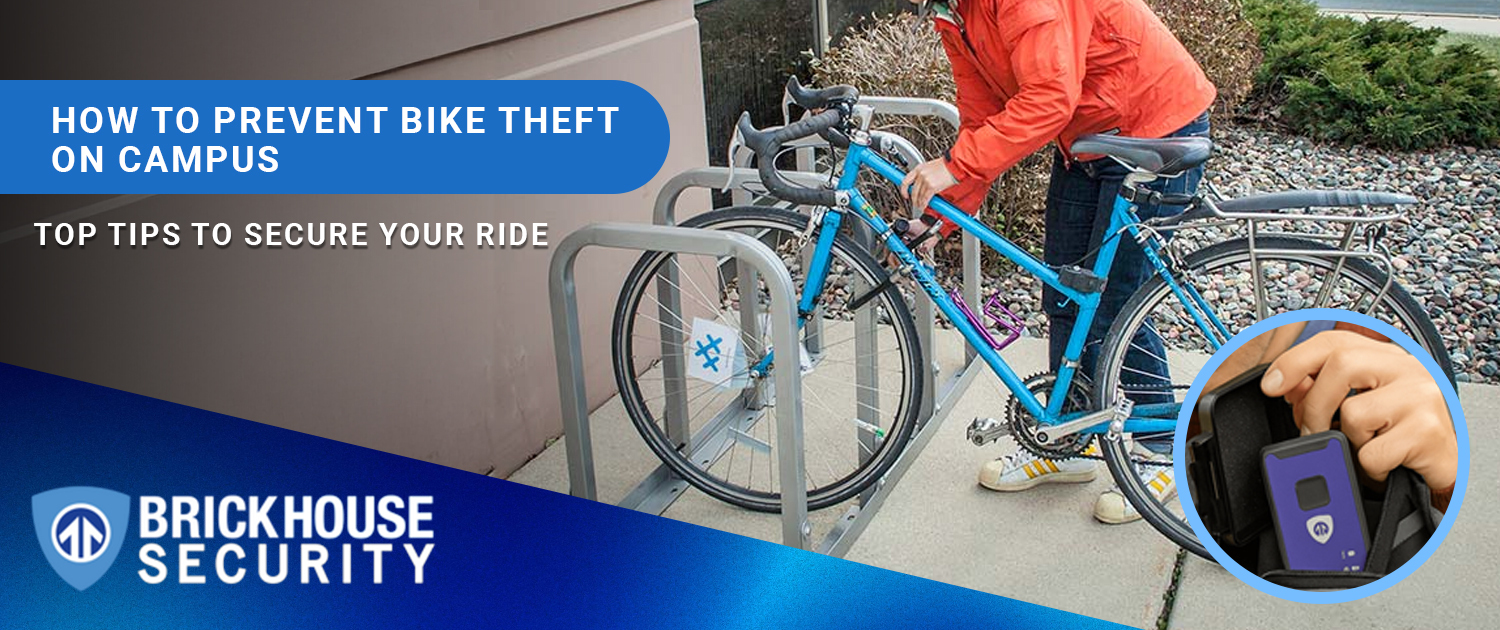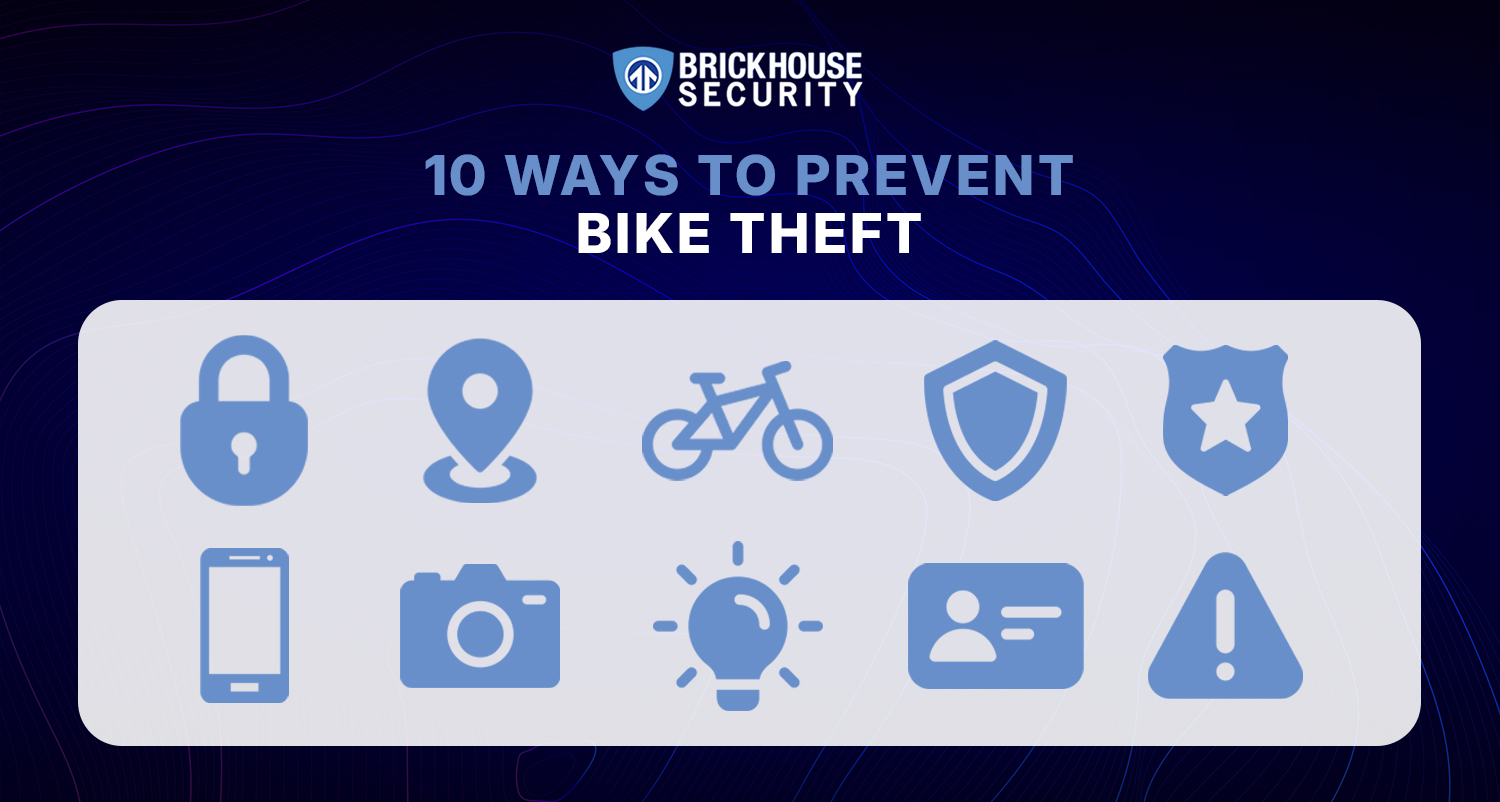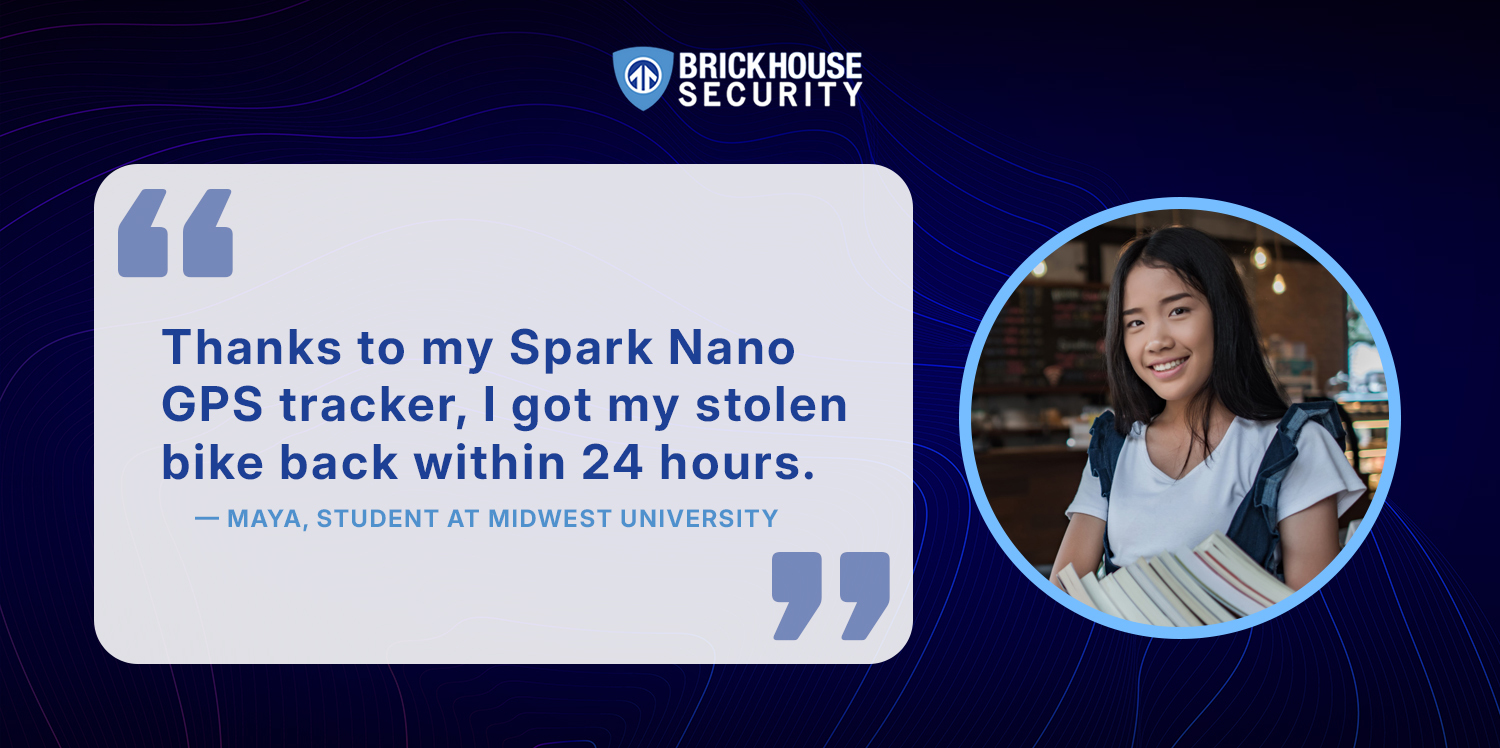Bike Theft Prevention: How to Prevent it on a College Campus

Bike theft is one of the most common crimes on college campuses, but with the right strategies, you can significantly reduce your risk of becoming a victim.
The fastest way to prevent bike theft on campus
Use a high-quality U-lock, register your bike with campus security, park in well-lit areas, and track it with a hidden GPS bike tracker. These proactive steps make your bike a tough target for thieves and easier to recover if it's ever stolen.
Why College Campuses Are Hotspots for Bike Theft
According to ResearchGate data, there are over 2.4 million bike thefts reported annually in the U.S., and a significant portion occur on college campuses. Schools such as UCLA, the University of Colorado, and the University of Wisconsin have all reported hundreds of incidents annually.
College campuses are among the locations where bikes are most commonly stolen, making them prime targets for theft.
Why? Because:
- Bikes are easy targets. They’re often left unattended for hours.
- Bike thieves know the schedule. Class changes and dorm rushes are predictable.
- Students are distracted. Many leave bikes unlocked or poorly secured.
Top 10 Ways to Prevent Bike Theft on Campus

1. Invest in a High-Quality U-Lock
Cable locks can be cut in seconds. A solid U-lock (ideally with a gold “Sold Secure” rating) is far more resistant to bolt cutters. However, even the best locks can eventually be broken with the right tools and enough time, so always choose the most secure option available.

Pro Tip: Use a U-lock and a secondary cable lock to secure both wheels and the frame.
2. Use a GPS Bike Tracker
Hidden GPS trackers can be a game-changer. At BrickHouse Security, we recommend compact trackers like the Spark Nano GPS, which fit under seats or inside frames.
- Real-time location updates
- Geo-fencing alerts if your bike moves
- Mobile app tracking for iOS & Android
![]()
3. Register Your Bike
Many universities partner with 529 Garage or local police departments. Registering requires providing your bike's serial number and other important information, such as make, model, and color. Services like Bike Index securely store your bike's details, including serial numbers, making it easier for authorities and shops to identify and recover stolen bikes. Local bike shops and other shops can also assist in verifying serial numbers and recovering stolen bikes.
4. Park Smart
Always park in:
- Well-lit areas
- High-traffic zones
- Designated campus bike racks (these provide secure locations to lock your bike’s frame and wheel)
Parking near lights and in well-lit areas helps deter theft and increases visibility.
Avoid isolated spots even if they’re closer to class.
5. Lock it Correctly
Secure the frame and at least one wheel to an immovable object. Lock it tight with minimal space between the bike and the lock.
6. Don't Leave It Overnight
Most thefts happen between 10 p.m. and 6 a.m. Bring your bike indoors when possible, especially overnight.
7. Engrave or Label It
Mark your bike with your student ID, phone number, or a unique identifier under the frame. Take a clear picture of your bike, including the serial number and any unique details, and keep it along with your purchase paperwork. These pictures serve as proof of ownership, which is essential if your bike is stolen. Having clear proof and pictures can help authorities and third parties confirm your ownership and increase the chances of recovering your bike.
8. Stay Aware of Campus Crime Alerts
Follow your school's safety alerts or apps like LiveSafe. Bike theft trends often follow patterns.
9. Use Indoor Storage When Possible
Some dorms and campus housing offer a secure indoor store or storage room for bikes. If it’s an option, use it.
10. Join or Start a Bike Watch Program
Community vigilance works. Every cyclist and person on campus can contribute to bike theft prevention by staying vigilant and reporting suspicious activity. Some campuses have peer bike patrols or student-led security initiatives.
Common Mistakes That Lead to Bike Theft
- Leaving bikes unlocked “just for a minute” These mistakes make it easier for thieves to steal bikes.
- Using only a cable lock
- Locking just the front wheel (the rest of the bike disappears!)
- Storing bikes outside overnight regularly
- Assuming daylight = safety
What To Do If Your Bike Is Stolen
- Report it immediately to campus police and local law enforcement. After reporting, make sure to file a stolen bike report and keep a file with all relevant documentation, including your bike’s serial number, photos, and proof of ownership. Filing this paperwork is crucial for recovering stolen bikes and for any insurance claim.
- Check GPS tracker data (if installed) to assist recovery. Acting quickly increases the chances of your bike being recovered by law enforcement or returned by a shop or pawn shop.
- Post on local forums or campus message boards. Make sure your stolen bike is posted on platforms like Project 529, Bike Index, and social media to alert the community and increase the chances of recovery.
- Check online marketplaces (Craigslist, Facebook Marketplace, eBay), as well as local pawn shops and bike shops. Stolen bikes are often posted for sale online or in shops, and thieves may try to sell them quickly. Alert local shops and pawn shops to be on the lookout for your bike by providing the serial number and description.
- Provide your bike’s serial number and photos. If your bike is found, contact the authorities or the shop immediately. You may need to provide proof of ownership to reclaim your bike. You should not have to pay law enforcement or pawn shops to recover your bike, but be prepared to file an insurance claim if your bike is not recovered. Insurance can help cover your losses, and filing a claim requires documentation and proof of ownership.
Recovering a stolen bike often depends on how quickly you act and how thoroughly you file reports and alert the community. The more steps you take, the better your chances of being reunited with your bike as its rightful owner.
Is Bike Theft on the Rise?
Yes. Especially with more students choosing eco-friendly transportation, bikes are valuable and easy to flip. According to a recent National Bike Registry report, bike theft increased by 24% on college campuses in the past five years. Nearly half of all stolen bikes are eventually recovered by law enforcement, so it's important to report thefts promptly to increase the chances of getting your bike back.
Real Example: GPS Helps Recover Stolen Bike in 24 Hours
One of our customers at a Midwestern university had their e-bike stolen from a campus rack. The process of recovering the bike involved close coordination between the owner and campus police, using the Spark Nano 7 GPS Tracker to track the bike’s movements and ensure it was returned to its rightful owner within 24 hours. The thief had no idea the tracker was there.

Conclusion: Stay One Step Ahead of Thieves
Bike theft is frustrating, but with the right tools and habits, you can protect your ride. Think of your bike like your laptop, you wouldn’t leave that unsecured in a public place, right?
- Use a U-lock
- Install a GPS tracker
- Register and lock your bike smart
- Be consistent with safety routines
FAQs About Preventing Bike Theft on Campus
What kind of bike lock is best for college campuses?
A heavy-duty U-lock with a Sold Secure Gold or ART 2+ rating is your best bet. Cable locks can be cut in seconds, so don’t rely on them alone.
Pro Tip: Use a second lock (like a cable or chain) to secure your front wheel or seat. Thieves look for easy targets, not puzzles.
Do GPS bike trackers work?
Yes, especially when they’re hidden well and paired with a reliable mobile app. A good GPS bike tracker can:
- Show your bike’s real-time location
- Alert you if your bike moves unexpectedly
- Help campus police or local law enforcement recover it quickly
Where should I install a GPS tracker on my bike?
Stealth is key. The most common hidden locations are:
- Under the seat
- Inside the handlebars
- Inside the frame tubing (some trackers are made to fit here)
Just make sure your tracker has a clear enough view to the sky to receive GPS signals.
Can my university help recover my stolen bike?
Yes, but time matters. If your bike is registered with campus police or a service like Project 529, they’ll have a much better chance of recovering it.
Many universities also coordinate with local bike shops, who can flag stolen bikes that come in for service or resale.
GPS tracking data can make all the difference, it gives police a real lead to act on.
How do I register my bike on campus?
Most schools offer one of two options:
- Register with campus police directly
- Use a national bike registry like Project 529
Registration is free or low-cost and links your bike’s serial number to your name, critical info if it’s stolen.
Is cable locking safe enough?
No, not on its own. Cable locks can be snipped in seconds with cheap tools. Always use a U-lock as your primary lock. Use the cable as backup, never the main line of defense.
What’s the most common time for bike theft on campus?
Most bike thefts happen late at night to early morning, usually between 10 p.m. and 6 a.m.
Should I bring my bike indoors overnight?
If you can, absolutely. Storing your bike indoors (even in a dorm hallway or locked basement) dramatically reduces theft risk. Out of sight, out of mind for thieves.
Can I use an Apple AirTag to track my bike?
Yes, but keep your expectations in check.
- AirTags don’t offer real-time tracking
- They rely on the presence of other Apple devices nearby
For serious bike protection, we recommend a dedicated GPS bike tracker with live tracking, motion alerts, and recovery features.
What should I do if I see someone tampering with bikes?
Safety first.
- Do not confront the person.
- Call campus police or security immediately.
- Provide as much detail as possible (location, description, time).
Want the best protection for your bike?
Check out GPS Bike Trackers and see which one fits your ride.
Posted by Adrienne Evangelista on Aug 18th 2025

